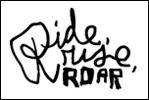
PRESS

SXSW: Byrne Doc Ride, Rise, Roar Burns With Strange Grace
By Michael Calore, Wired,
25 March 2010 [Link]
Most of the time, David Byrne�s face is a mask of stoicism. He speaks in a scattered monotone. His smile can seem forced. He�s a thoughtful artist, a serious guy.
But there are moments in Ride, Rise, Roar, the new documentary by David Hillman Curtis that centers on Byrne, when the musician is obviously and sincerely overjoyed. They happen when he�s onstage performing. He�s bouncing on his feet, yelping and grinning from ear to ear.
The movie chronicles the live shows Byrne and his band played to promote his 2008 collaboration with Brian Eno, Everything That Happens Will Happen Today. For the show, the band played a selection of songs from all of Eno and Byrne�s collaborations, including the Talking Heads albums More Songs About Buildings and Food, Remain in Light and Fear of Music. Their first Duo project, My Life in the Bush of Ghosts, was skipped, at least in the film.
No stranger to theatrical bunting, Byrne added a troupe of three modern dancers to the onstage cast. The result isn�t a stuffy piece of hybrid dance/live-performance theater, but rather a rock show filled with great songs and some really bizarre, energetic and sexy dancing.
Ride, Rise, Roar had its world premiere at the South by Southwest Film Festival. The film was well-received, with the audience clapping and cheering after each song in the movie like they were watching a live performance.
Byrne was tightly involved in the filming. During the Q&A session after the premiere, director Curtis said the crew initially shot only a few shows on the first leg of the tour, then assembled a rough cut. They showed it to Byrne, and he thought they could do better (�His reaction was, �Eh, maybe ��� said Curtis). Byrne later insisted the film crew come shoot more footage at the end of the tour, sensing the quality of the shows had improved.
�He was right,� Curtis said. �They had gotten much better.� After seeing another cut, Byrne got really excited about the film. Byrne wasn�t in Austin for the SXSW premiere, but he has seen the finished product.
Ride, Rise, Roar is a downright beautifully shot and edited concert film. The whole thing was captured on Red cameras, which shoot video at a resolution far beyond the capability of current HDTVs. The high-definition picture is extremely crisp, even when the stage is dimly lit. Curtis and his crew usually set up two stationary cameras in the concert venue, then took three handheld units onto the stage with the performers. But since the finished movie combines footage from seven or eight shows, the filmmakers were able to intercut shots from different nights, making it appear as if there were twice as many cameras present as there actually were.
A huge plus: Every song in the movie is shown in its entirety. Between songs, we get to see footage of rehearsals or interviews with the musicians. Some of the backstage stuff is laugh-out-loud funny, and it helps lighten the film�s pacing.
But it�s the live sequences that are truly extraordinary. You wouldn�t be mocked for feeling apprehensive about a show that combines pop music with modern dance � �An idea fraught with danger,� Curtis said � but the results are quite awesome. The dancers aren�t just there to add a dramatic visual element to the show. In some songs, they actually �play� the band, moving the microphones around on the stage (�I Zimbra�) and forcing the musicians to do things with their bodies they wouldn�t normally do (�I Feel My Stuff�).
In one song, everyone is seated, with Byrne and the dancers doing a little routine on rolling office chairs. In another, the three dancers pick up guitars and mimic Byrne�s jerky soloing. For the �Burning Down the House� encore, everyone � the band and the dancers � comes onstage wearing tutus.
Even though it looks like a bunch of songs from a single show, the performances in Ride, Rise Roar are actually spread out over about year. It helped that Byrne, his band and the dancers wore the same, all-white wardrobe every night, and that the shows were highly choreographed, so the performers were doing the same things at the same times from night to night.
The movie tracks the entire process of building the stage shows with the choreographers, from auditions through rehearsals as well as some scenes from the road. There are also interviews with the choreographers, which are unintentionally funny � dancers have a way of speaking about their craft in the oddest terms, and the audience at the premiere couldn�t help but collectively giggle a few times.
Byrne shows up in half of the documentary sequences. He gives a tour of his home studio to show how he worked on the album � he and Eno would send each other ideas as MP3s over e-mail, and Byrne would chant wordless lyrical melodies on top of them. His studio desk is about as disorganized and messy as the average tech worker�s. There are also some slow-motion shots of Byrne riding his bike around New York � an avid cyclist, Byrne has written a book about his passion for two-wheeled transport. Watch closely during the biking sequence and you�ll see Byrne run a red light and almost take down a pedestrian.
Eno also pops up near the end. He and Byrne play some tracks from their album on a stereo and talk about how the sounds were created.
Actually, Eno does the talking and Byrne mostly nods. Byrne isn�t onstage dancing. He�s back in serious artist mode.
| TOP | PRESS |

